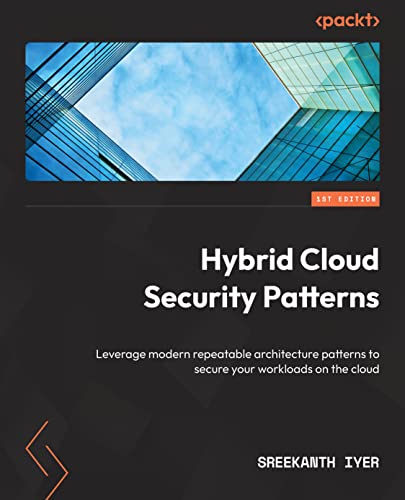Sreekanth Iyer is the author of Hybrid Cloud Security Patterns, we got the chance to sit down and find out more about his experience of writing with Packt.
Q: What are your specialist tech areas?
Sreekanth: Cloud Native Application Development, Information Security, Service Oriented Architecture, Application and Integration Architecture, Java
Q: How did you become an author for Packt? Tell us about your journey. What was your motivation for writing this book?
Sreekanth: I used to share my knowledge in the form of blogs. The technical areas covered in my blogs are mainly architecture, hybrid cloud and information security. Packt team contacted me for authoring a book on IBM Cloud. I discussed with the team and narrowed down on hybrid cloud security as the area. Hybrid Cloud is fast emerging space, and it is difficult for individuals to stay upto speed on all the technologies and developments. Taking a patterns-based approach help practitioners get upto speed in this area. My motivation is to share this knowledge on patterns.
Q: What kind of research did you do, and how long did you spend researching before beginning the book?
Sreekanth: I’ve gained the knowledge working in this space for the last one decade. I’ve been building cloud native products as well as consulting with enterprise clients for their adoption of hybrid multicloud model. This has provided me the insights on the challenges that need to address for deploying securely to cloud. These patterns have been discovered, tried, curated over the last several years.
Q: Did you face any challenges during the writing process? How did you overcome them?
Sreekanth: The authoring process requires immense concentration. We need to understand that what we are trying to put down on paper is for others to read and understand. So have to evolve the clarity in terms of describing the context as well as discussing the solution. Though I had been collecting the different security patterns across many years, never had the time to sit and write down this part. As mentioned, this needs exclusive time for the required attention on the topic and difficult to context switch if you try to do it between tasks. I was planning to complete this earlier this year but because of some emergencies, I could not complete on time. Thanks to the motivation and support provided by the Packt team, I was able to finish writing up the 10 chapters.
Q: What’s your take on the technologies discussed in the book? Where do you see these technologies heading in the future?
Sreekanth: The key technologies discussed in this book covers areas of identity and access management, infrastructure, data and application security and security intelligence. As we can see there is technology advancements happening in all of these domains. Traditionally these technologies were mainly focusing on how to secure resources on-premises. Now these technologies are evolving to address the same set of requirements for a hybrid multicloud world. The paradigm shift to leveraging zero trust as a model in this environment is a major change in the approach. Many of these technologies will need to support the zero-trust approach for security. Compliance requirements will also drive how these technologies are poised to change in the coming days.
Q: Why should readers choose this book over others already on the market? How would you differentiate your book from its competition?
Sreekanth: Security is a very wide topic and multidimensional puzzle to solve. A security architect or an engineer, needs to think in different dimension to create a secure application on cloud. You will find books that deep dives on topic like network security, data security or application security. But it is difficult for a network security engineer to learn application security. The learning curve is big. But with taking a patterns-based approach, it is very easy to learn the context and solution. My book provides a way to easily understand the security and compliance challenges in each layer of the cloud stack and discusses suitable options to address them. Then it also puts it together to take a holistic approach from operations and solution approach including how to leverage these patterns for building a dev-sec-ops pipeline or a zero- trust security architecture
Q: What are the key takeaways you want readers to come away with from the book?
Sreekanth: Security is a complex subject. Hybrid multicloud makes it even more difficult. This book provides a simple pattern based approach to address cloud security. You will be able to implement security for all your cloud deployments without having the need to be a security expert. The book discusses the patterns and how to implement the security patterns with specific cloud providers and pointers to tutorials and easy-to-follow prescriptive guidance.
Complete with pointers to tutorials and guidance on how to secure or implement security patterns on specific clouds – AWS, Azure, GCP and IBM Cloud. Hybrid Cloud Security Patterns is a comprehensive introduction of cloud Security Patterns.
Q. Do you have a blog that readers can follow?
Sreekanth: https://hybridcloud.medium.com/
Q. What advice would you give to readers learning tech? Do you have any top tips?
Sreekanth: Hybrid cloud is the new normal. Multi clouds is a strategy adopted by all enterprises. The cloud applications must be built with security as the prime consideration and differentiator. Security should not be an afterthought and must be considered early as part of the development cycle. Cloud Security is a complex topic but taking a patterns-based approach can reduce the learning time. In learning tech, there is difference between knowing and doing. Whatever knowledge gained through reading, we have to solidify the understanding by doing and trying it out.
Q. What are your favorite tech journals? How do you keep yourself up to date on tech?
Sreekanth: I’m subscribed to newsletters from ETCIO, TechTarget, Stackoverflow, timestechies and the differnt cloud providers – AWS, Google, Azure and IBM. I also listen to podcasts on the new stacks like kubernetes, data world etc as well as the publications from market analysts like gartner, forrester to learn the latest technical trends. On identifying few major technologies that can have future impact, I sign up for a course on the same with coursera or udemy.
Q. Can you share any blogs, websites and forums to help readers gain a holistic view of the tech they are learning?
Sreekanth: https://securityintelligence.com/, https://www.opengroup.org/forum/security, https://www.cncf.io/
Q. How would you describe your author’s journey with Packt? Would you recommend Packt to aspiring authors?
Sreekanth: It has been an awesome fulfilling journey with Packt. The team provided space and time to work on the content. Once the content was ready, they supported with the reviews and inputs to make the content more consumable and engaging. If you are an aspiring author, start with putting down the outline of the topics, you want to share. As you will start writing it down, you will realize you have a lot to share and talk about. I would say just start.
Q. Do you belong to any tech community groups?
Sreekanth: opengroup.org, https://www.globalaea.org/page/AboutUS. https://engage.isaca.org/bangalorechapter/home
Q. How did you organize, plan, and prioritize your work and write the book?
Sreekanth: I’d to commit many weekends to be dedicated for the work on the writing of this book. Unfortunately, because of some personal emergencies all of the work did not complete on time during the weekends. So, few days I decided to wake up early and commit an hour daily for the authoring of this book. Later after finishing the content, I would block 3 to 4 hours’ time to work on the creating the pictures for each chapter. Authoring of a book is a huge commitment. There will be different type of hurdles. Learnt that we need to plan for all such situations.
Q. What is that one writing tip that you found most crucial and would like to share with aspiring authors?
Sreekanth: We have to write with a target audience in mind. The read whatever has been written with the wearing a target persona hat. If things are not clear, re-write. Use diagrams and examples or case studies as appropriate which helps to make the complex topic clear.
Q. Would you like to share your social handles? If so, please share.
Sreekanth: https://www.linkedin.com/in/sreekiyer/, twitter – @sreek, https://twitter.com/sreek, https://www.facebook.com/sreekiyer/, medium – https://hybridcloud.medium.com/
You can find Sreekanth’s book on Amazon by following this link: Please click here









